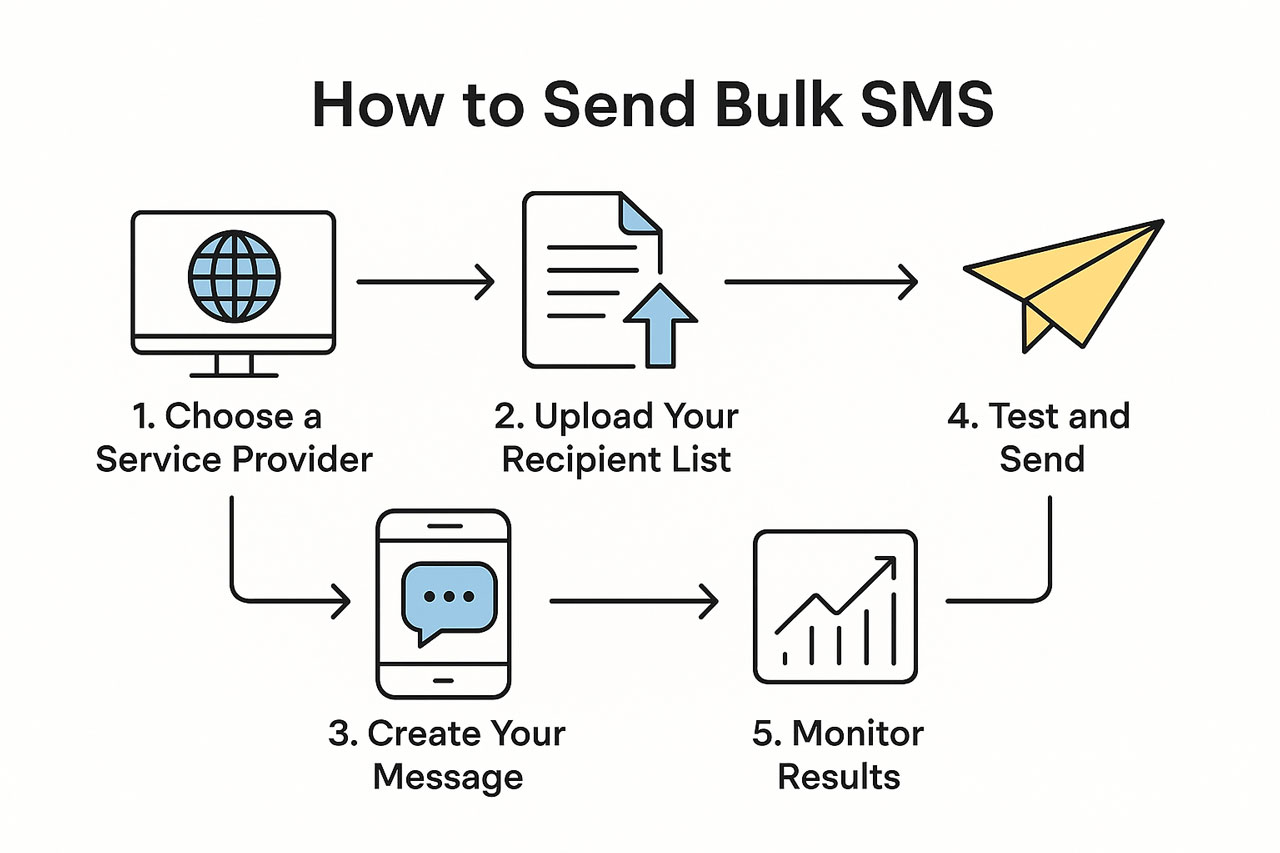Sending bulk SMS has become a cornerstone of modern communication strategies, especially for businesses looking to engage customers quickly and effectively. Whether you’re sending transactional SMS, marketing messages, or using SMS for voice OTPs in customer authentication, knowing how to send bulk SMS is a skill that can significantly enhance your outreach. Bulk SMS allows businesses to reach thousands, if not millions, of customers at once, with minimal effort and maximum impact. But to make the most of this communication tool, it’s essential to understand the best practices, tools, and technologies that make the process efficient and successful.
In this step-by-step guide, we will walk you through everything you need to know about sending bulk SMS, from selecting the right platform to crafting effective messages that resonate with your audience. Whether you’re an IT professional, cybersecurity expert, or telecom engineer, this guide is tailored to ensure that you have the knowledge to execute bulk SMS campaigns like a pro. We’ll also explore how global messaging providers like SMSala have revolutionized the process of sending bulk SMS for OTP, marketing, and more, making it easier for businesses to scale their communication efforts worldwide.
What is Bulk SMS?
Before diving into how to send bulk SMS, let’s clarify what it actually means. Bulk SMS refers to the process of sending a large number of text messages to a large group of recipients simultaneously. This can include various types of messages, such as promotional offers, service notifications, OTPs for customer authentication, and more. Bulk SMS is often utilized by companies, government agencies, banks, and e-commerce platforms to engage with their customers efficiently and quickly.
The ability to send bulk SMS at scale is crucial for any business or organization aiming to maintain contact with their customers in a timely manner. Whether it’s sending a reminder about an upcoming sale or delivering a security code for login verification, bulk SMS plays a vital role in communication strategies across industries.
Why Use Bulk SMS?
You might be wondering why bulk SMS is such a vital communication channel. The reason is simple: SMS boasts one of the highest open rates compared to email or other digital marketing channels. Text messages are read almost immediately by recipients, often within just minutes of being received. This is a powerful feature for businesses seeking quick, direct engagement.
Moreover, SMS has a higher level of accessibility. Unlike email, which may be filtered or ignored, SMS messages are received directly on the phone, which most people check throughout the day. This is why using bulk SMS for critical communications like OTPs, security alerts, and promotional messages ensures that the information reaches your audience swiftly and reliably.
Step 1: Choose the Right Bulk SMS Service Provider
The first step in sending bulk SMS is selecting a reliable bulk SMS service provider. This is a critical decision because the quality of service you receive can make or break your messaging campaigns. When evaluating potential providers, consider the following factors:
-
API Integration: Does the service provider offer an easy-to-use API for integrating bulk SMS into your application or platform? For example, SMSala, a global leader in messaging solutions, offers robust Global Bulk SMS APIs that allow you to send SMS messages globally, whether for OTPs or marketing campaigns.
-
Global Reach: Can the provider send SMS to the regions or countries you intend to target? A reputable provider like SMSala has global coverage and ensures that messages reach recipients no matter where they are.
-
Reliability & Speed: Look for a service provider with a proven track record for delivering SMS quickly and reliably. You don’t want delays or failures when sending important messages.
-
Pricing: Different providers will have varying pricing models, so ensure you understand the costs involved, especially when sending large volumes of SMS.
-
Delivery Reports: Opt for a service that provides detailed delivery reports. This feature will help you track the success of your campaigns and optimize future efforts.
Step 2: Register for an Account and Set Up Your Sender ID
Once you’ve chosen your provider, the next step is to register for an account. Most providers will require you to create an account on their platform before you can send bulk SMS. You will need to provide your contact details, business information, and payment details if applicable.
Next, you will need to set up your sender ID. The sender ID is the name or number that will appear on the recipient’s phone when they receive your message. Depending on the provider, you may have the option to use a dedicated short code, a long code, or a custom alphanumeric sender ID.
It’s important to note that some countries have strict regulations regarding sender IDs. For instance, in some regions, you may only be allowed to use a dedicated short code for marketing messages or promotional SMS.
Step 3: Create Your Bulk SMS Message
Now comes the most critical part: crafting your bulk SMS message. You need to ensure that your message is clear, concise, and actionable. Keep in mind that SMS messages have a character limit (usually 160 characters), so every word should count. Here are a few tips for creating effective bulk SMS content:
-
Be direct and to the point: Avoid unnecessary words. Focus on your main message, whether it’s a promotional offer or an OTP for verification.
-
Use a clear call-to-action (CTA): Your message should encourage recipients to take action, such as clicking a link, replying with a keyword, or completing a transaction.
-
Personalize your messages: If possible, include the recipient’s name or other personalized information to increase engagement. For example: “Hi John, your OTP is 123456.”
-
Respect your audience’s time: Don’t overload them with too much information. Stick to one core message per SMS.
Step 4: Upload Your Recipient List
After crafting your SMS message, the next step is to upload your recipient list. This is the list of phone numbers to which you will send your bulk SMS. Your service provider will typically allow you to upload the list in formats such as CSV, Excel, or TXT.
Ensure that your recipient list is clean and accurate. Invalid or incorrect phone numbers can result in message failures and affect the success of your campaign. Some bulk SMS providers offer features like number validation, which ensures that the numbers on your list are valid and deliverable.
For added personalization, many bulk SMS services allow you to import contact fields such as names, addresses, or transaction details. This ensures that your messages can be customized for each recipient.
Step 5: Test Your Campaign
Before sending your bulk SMS to thousands of recipients, it’s a good practice to test your campaign. Send your message to a small group of internal users or colleagues to ensure everything is functioning as expected. This includes:
-
Ensuring the message displays correctly on all devices (SMS can look different on various phone models).
-
Checking that any links or phone numbers included in the message are working properly.
-
Verifying that the sender ID is set up correctly.
Testing allows you to spot potential issues before sending out messages at scale, ensuring a smoother process.
Step 6: Schedule and Send Your Bulk SMS
Once everything is set up and tested, it’s time to schedule and send your bulk SMS. Some platforms, like SMSala, allow you to schedule your messages to be sent at a specific time, ensuring that they reach recipients when they are most likely to engage with them.
Scheduling is particularly useful for time-sensitive messages such as promotional offers, reminders, or security codes. For example, you may want to send a reminder about a flash sale that starts at noon or an OTP that expires within 10 minutes.
Step 7: Monitor and Analyze Campaign Performance
After sending your bulk SMS campaign, it’s crucial to monitor and analyze its performance. Most providers, including SMSala, offer delivery reports and analytics dashboards to track key metrics, such as:
-
Delivery rate: How many messages were successfully delivered to recipients?
-
Open rate: How many recipients opened or engaged with the message?
-
Response rate: How many people took action, such as replying to the message or clicking a link?
By analyzing these metrics, you can evaluate the success of your campaign and adjust future campaigns to improve results.
Conclusion: Mastering Bulk SMS for Business Growth
Sending bulk SMS is a straightforward but powerful way to engage with your audience. By selecting the right platform, crafting effective messages, and leveraging the global capabilities of providers like SMSala, you can enhance your communication strategy and drive better customer engagement. Whether you’re using SMS for marketing, security, or customer service, following these steps will help you get the most out of this powerful tool.
Remember, bulk SMS is more than just sending messages—it’s about creating meaningful connections with your audience, whether for promotional purposes, OTPs, or time-sensitive notifications. With the right approach and tools, you can maximize your impact and drive business growth.



